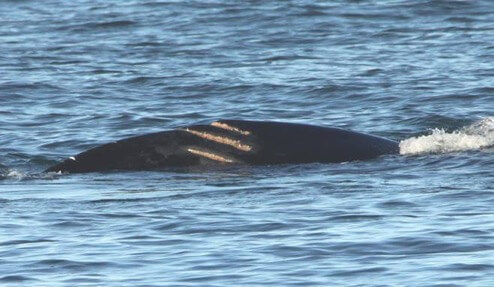A first North Atlantic right whale carcass has been discovered this year. North Atlantic right whales are considered endangered and their population is estimated to number 411 individuals. The carcass was spotted on June 4 during an aerial survey carried out by the US National Oceanic and Atmospheric Administration (NOAA). It was approximately 50 nautical miles from the Gaspé coast.
Overflights by Fisheries and Oceans Canada and patrols by the Canadian Coast Guard were carried out on June 5 to relocate the animal. Fisheries and Oceans Canada, the Quebec Marine Mammal Emergency Response Network and the Marine Animal Response Society are evaluating the possibility of towing the carcass to Miscou Island for analysis in the coming days. A comprehensive necropsy might help determine the cause of the animal’s death.
The logistical challenges of transporting a North Atlantic right whale are multiple, given the size and weight of the individual. The distance to the coast (approx. 13 hours away) adds to the complexity of the operation. Organizing a necropsy also requires expertise and a sizable workforce to carve up the enormous body. Nevertheless, the answers that might be provided by the analysis could serve to better inform conservation measures.
A right whale named Wolverine
The New England Aquarium team has identified the right whale. It is Wolverine, a male born in 2010 to female 3123. He owed his name to three large scars at the base of his tail, the result of a collision with an engine propeller when he was 5 years old. During the first five years of his life, Wolverine was seen entangled three times, with two of these entanglements considered minor and one moderate, according to the standards developed by the New England Aquarium. This individual was seen in 2017 and 2018 in the Gulf of St. Lawrence. At the current time, we do not know the cause of the mortality.
A changing ecosystem
Part of the North Atlantic right whale population has traditionally spent summers in the Bay of Fundy. Since 2017, the Bay of Fundy appears to be less heavily visited and a major increase in right whale sightings has been noted in the Gulf of St. Lawrence. In 2017, twelve right whale carcasses were found in the Gulf. Mitigation measures to lower the risks of entanglement and collisions were urgently implemented that summer. Measures were also applied in 2018; no carcasses were found that year. This year, speed reduction zones and mitigation measures have once again been put into place.





